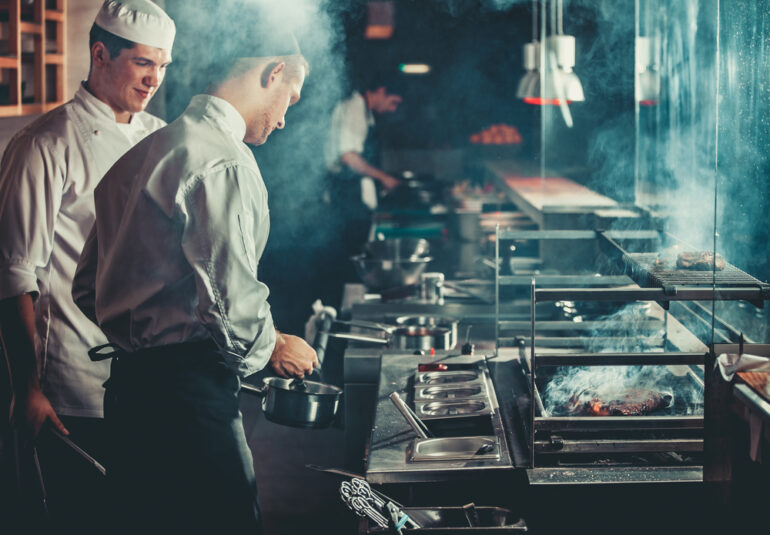A cluttered and unorganized commercial kitchen is a restaurant owner’s or a chef’s worst nightmare, as it may lead to lost productivity, misplaced equipment, and dissatisfied customers due to delayed service. Even if you have a smaller commercial kitchen, a large industrial kitchen, or if you are a home cook, everyone wishes for a well-organized workspace.
Smart Ways to Organize Your Commercial Kitchen
Check out these tips and ideas when designing a neat and well-organized kitchen for your restaurant.
Deep Clean
It’s just as crucial to keep your commercial kitchen clean as it is to organize storage and set up workstations. Bacteria can thrive on dirty surfaces, resulting in food poisoning and other food-borne illnesses. Dirt, filth, and oil grease buildup in the vents, on the stovetops, and in the ovens can give the meal a bad odor and taste.
Create a plan for your commercial kitchen
Chalking out a detailed plan for the storage and shelving helps your employees find the equipment that they need when cooking within their reach. This results in lesser injuries and mishaps.
When creating the plan, be sure to ask yourself questions related to:
- The space available – these areas should be outfitted with the right commercial kitchen equipment for the volume and type of food you serve
- The menu; as it allows you to arrange and list the equipment needed
- The shift that needs to be covered
- And the number of employees needed to cover all the shifts.
Create separate workstations
Creating separate workstations for every level of food preparation causes less clutter, resulting in quick service. Separate workstations for cutting, frying, baking, grilling, platting, and washing can help avoid cross-contamination. This also allows employees to work in their separate spaces, reduce run-ins with other employees, and prepare ingredients needed for cooking well in advance. This saves time and streamlines the day-to-day process.
Keep everything within easy reach
Keeping equipment and tools close to your prep station cuts down on the time it takes to complete a task. When you’re in the middle of preparing a meal, the last thing you want to do is go out of your way to locate the most commonly used ingredients. Hanging and storing commonly used items allows chefs to focus on cooking and serving the food rather than wasting time looking for a certain spatula or saucepan.
Hang up pots & pans
Pots, pans, spoons, and other frequently used items can be hung up to make it easier for your staff to use them without making a mess. This also aids in the reduction of space used. In a tiny commercial kitchen, pegboards and towel racks are an excellent way to save space.
Label everything
Labeling is one of the most effective ways to quickly organize a commercial kitchen. Everything should have a good label that is always visible, from ingredients to cleaning products. Serving a customer the wrong product or a contaminated or ruined item can be disastrous for your business, especially if someone becomes ill. Make a list of what each cabinet, drawer, and bin is for, and then attach a tag or a marker to them so you can see what they’re for at a look. You wouldn’t want to provide ordinary pasta to a customer who requested gluten-free pasta.
Apply the first in-first out method
The first in-first out (FIFO) technique should be used for items with a shorter shelf life. You can achieve this by splitting the food into distinct parts and keeping the most recent items at the back. This implies that the food that has to be cooked first will be in the front and easy to access, reducing rot and waste. You can use the FIFO approach for all of the ingredients that go into your refrigerator, freezer, and pantry.
The Importance of Keeping your Commercial Kitchen Organized
- Firstly, it increases efficiency by reducing the time spent in the kitchen looking for a specific knife or spoon, which can then be used to produce high-quality dishes or serve ready-to-eat food to customers.
- It also makes the kitchen a safer place to work in. When cooks have everything they need within arm’s reach, they have less need to move around, which means there are fewer chances of colliding with someone and suffering burns or cuts. This reduces workplace injuries, making for a more pleasant and stress-free working environment.
- A well-organized kitchen also helps to avoid food waste and equipment damage, both of which add to unwelcome costs. It also allows restaurant operators to put the money saved to better use in other areas like marketing or décor.
Working in an orderly and clean kitchen motivates employees to deliver food quickly without compromising on the quality or the service. Good food and clean ambience are factors that are the first to be considered when going to any restaurant.
 Author BIO: Damon Shrauner, Senior Sales Consultant and VP on B2B Sales at ChefBuyer working in the foodservice equipment sector since 1994. With his expertise in market analysis, product placement, sales, and project management, he will always tell you what to do for the best of your business.
Author BIO: Damon Shrauner, Senior Sales Consultant and VP on B2B Sales at ChefBuyer working in the foodservice equipment sector since 1994. With his expertise in market analysis, product placement, sales, and project management, he will always tell you what to do for the best of your business.







